SHINYO!
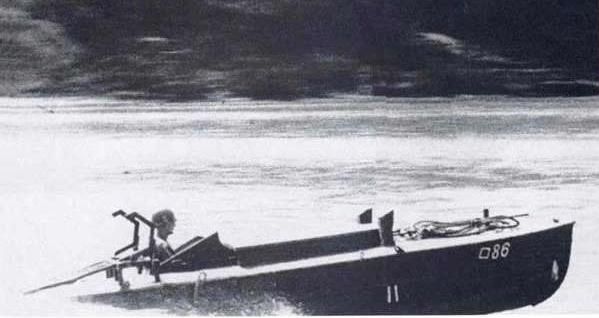 (Captured EMB under test by a 77th Inf Div officer)
(Captured EMB under test by a 77th Inf Div officer)
Explosive Motorboats based at Okinawa
1944-1945
© 2009-2011 Bob Hackett and Sander Kingsepp
September 1944:
Okinawa.
The 27th Squadron of “Shinyo”(Ocean Shaker) explosive motor boats (EMB) is based at Unten Bay on
the Okinawa's northern coast.
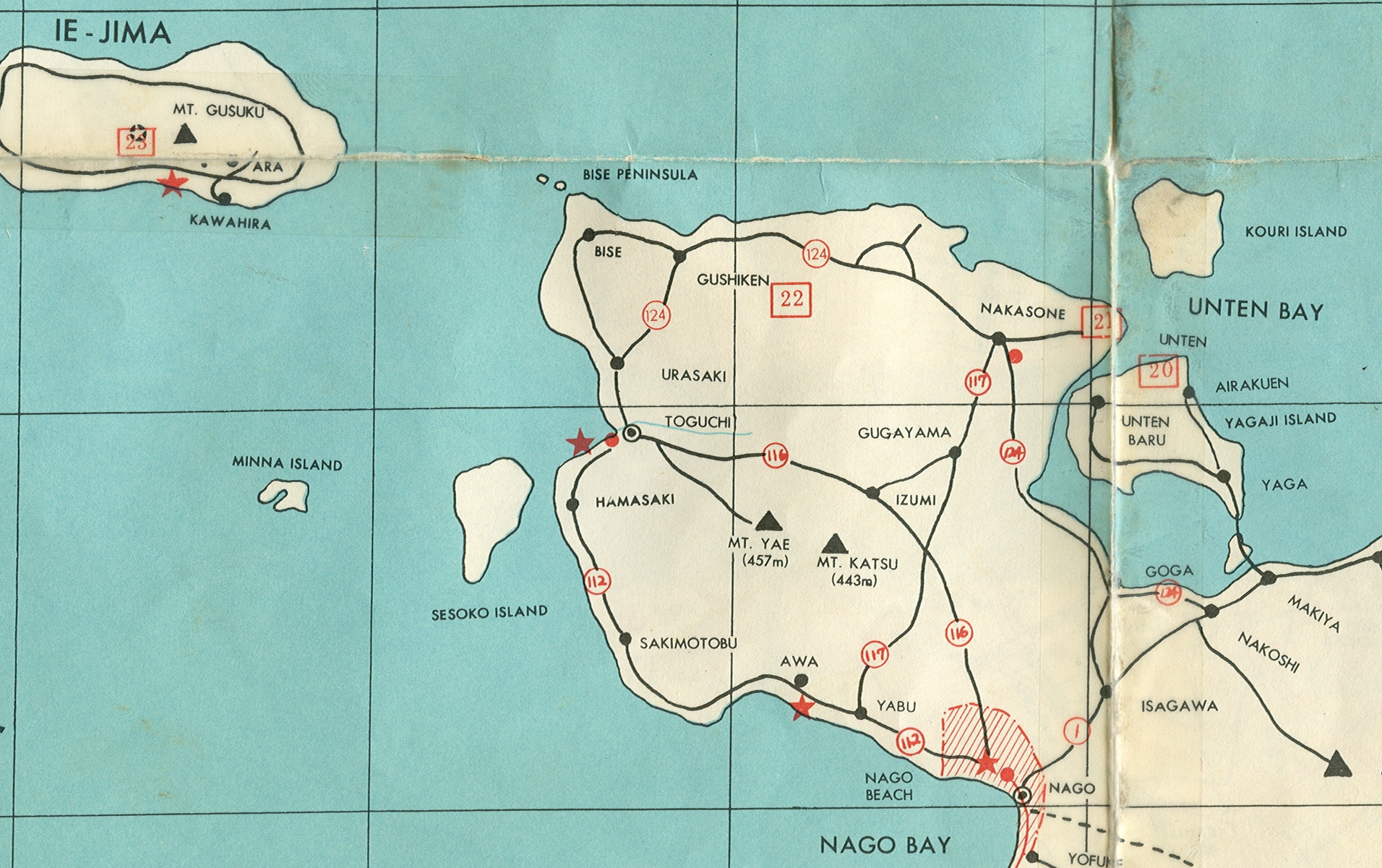 Unten Bay, Okinawa
(1968 CalTex road map)
10 October 1944:
Unten Bay, Okinawa
(1968 CalTex road map)
10 October 1944:
Vice-Admiral (later Admiral) Marc A. Mitscher's (former CO of HORNET, CV-8) Task Force 38 launch the first strikes on Okinawa for the pre-invasion landings on Leyte, Philippines. TF 38's aircraft strike the Okinawa area and the Unten base that is about 80 percent complete.
Late October 1944:
Nagasaki. The 22nd Shinyo Special Attack Squadron is formed at the Kawatana Torpedo Boat Training School.
15 January 1945:
Lt Toyohiro’s 22nd Shinyo Squadron (SS) arrives at Naha, Okinawa with 45 EMBs and establishes a base near Chinen, SE Okinawa.
18 January 1945:
Auxiliary gunboat CHOHAKUSAN MARU departs Sasebo for Ishigaki-Jima escorted by subchaser CH-58 and kaibokan CD-22. CHOHAKUSAN MARU carries an unknown number of Shinyo EMBs of the 38th SS’s authorized 50 EMBs.
26 January 1945:
Koa, Okinawa. The 22nd Shinyo Special Attack Squadron is stationed at Koa Meeting Hall (now Kin Public Hall). The squadron undergoes intense attack training each day at the beach near the Hall, which serves as a launch site for the motor boats.
28 January 1945:
CHOHAKUSAN MARU arrives at Ishigaki-Jima and off loads her cargo of Shinyo EMBs for the 38th Shinyo Squadron.
1 March 1945:
Lt Imoto's 42nd SS arrives at Nakagusuku Bay with 17 operational EMBs of her authorized 48. The squadron, with 85 pilots, establishes a base near Yontan Okinawa.
In addition, the 41st SS with 55 authorized EMBs is based in the Miyako Islands, the 19th SS with 50 authorized EMBs, 23rd SS with 52 authorized EMBs, 26th SS with 52 authorized EMBs, and 38th SS with 50 authorized EMBs, are at Ishigaki-jima in the Yaeyamas.
The 18th SS with 52 authorized EMBs, 40th SS with 55 authorized EMBs and 44th SS with 55 authorized EMBs are at Amami O-Shima, Ryukyus.
10 March 1945:
N of Amami O-Shima. At 0710, LtCdr Edward Ackerman’s USS KETE (SS-369) torpedoes and sinks KEIZAN MARU enroute from Kagoshima, Japan to Naha, Okinawa carrying a cargo of 30 Shinyo EMBs, 12 aerial torpedoes, 1000-tons of equipment and 500 barrels of gasoline.
14 March 1945:
Kin Bay, Okinawa. A B-24 "Liberator" heavy bomber makes a surprise attack on Lt Toyohiro’s 22nd Shinyo Squadron while the squadron is training. 18 men are KIA in the attack and 10 Shinyo EMBs destroyed.
23 March 1945:
87 miles NNW of Naha. At 1713, LtCdr William J. Germershausen's USS SPADEFISH (SS-411) torpedoes and sinks DORYO MARU carrying a unit of IJA troops, 189 men of the 39th Shinyo Squadron and 28 Shinyo EMBs. 322 officers and men and the crew including 129 men of the 39th SS are KIA. [1]
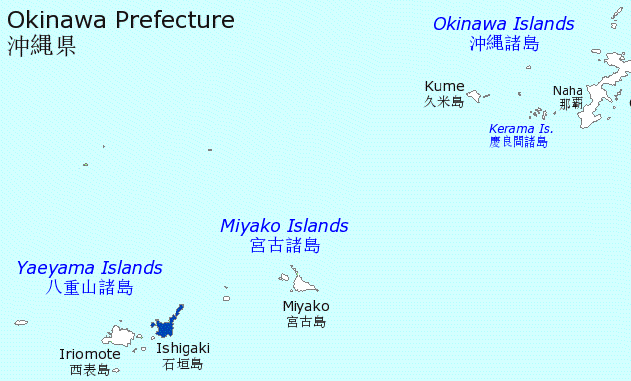 Miyako and Yaeyama Islands.
23-27 March 1945:
Miyako and Yaeyama Islands.
23-27 March 1945:
Aircraft from Task Force 58 conduct four days of intensive strikes on invasion beach defenses, anti-aircraft and coastal battery emplacements and military headquarters buildings.
Kerama Retto. That same day, Rear Admiral (later Vice Admiral) Morton L. Deyo’s Task Force 54’s battleships, cruisers and destroyers bombard Kerama and the SE coast of Okinawa.
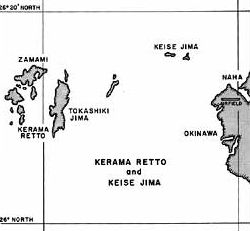 Kerama Retto.
(U.S. Army)
Kerama Retto.
(U.S. Army)
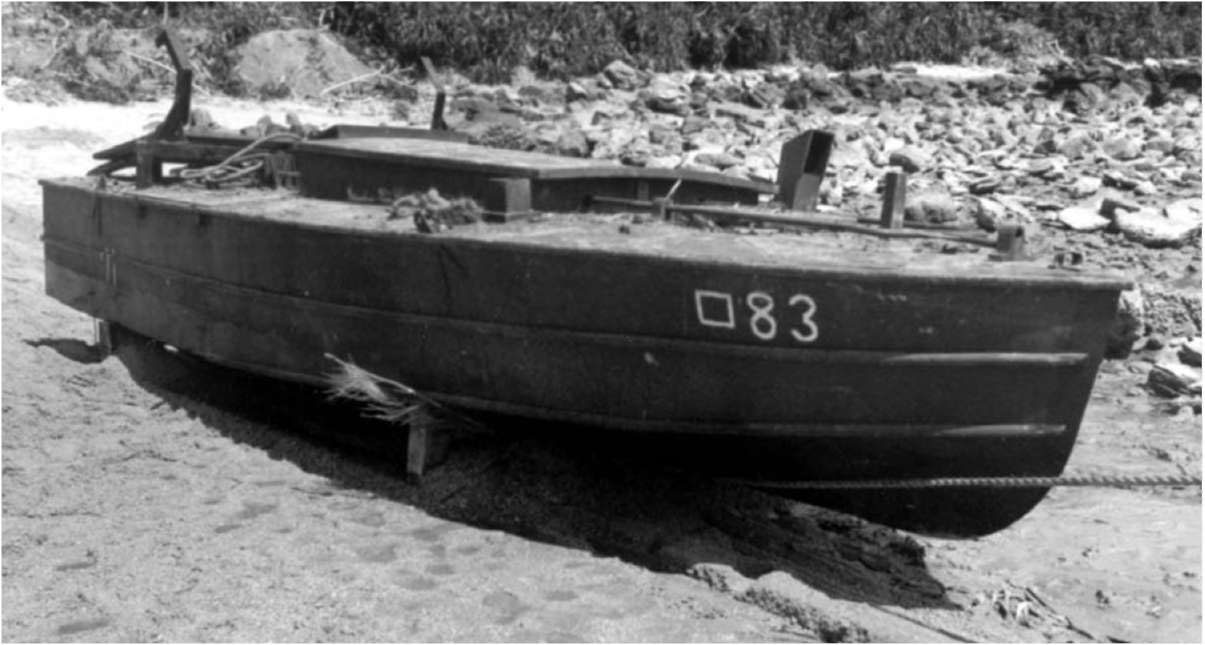 An IJA EMB in the Keramas.
(U.S. Army)
26 March 1945:
An IJA EMB in the Keramas.
(U.S. Army)
26 March 1945:
Kerama Retto, 15 miles off Okinawa's southwestern tip. New York's 77th Infantry "Statue of Liberty" Division lands to capture advance bases and anchorages for the invasion of the main island of Okinawa. The 77th captures and destroys more than 300 IJA "Maru-ni" EMBs that were well dispersed in well camouflaged hideouts. Not one of these EMBs attacked a single American ship. [2]
 Wrecked EMBs captured by the 77th Infantry Division in the Keramas.
(U.S. Army)
29 March 1945:
Wrecked EMBs captured by the 77th Infantry Division in the Keramas.
(U.S. Army)
29 March 1945:
15 EMBs of the 42nd Shinyo Squadron sortie at night, but find no targets. While returning to Yontan in the daytime, they are attacked by USN aircraft and all are sunk.
31 March 1945:
About 50 IJA Maru-ni EMBs based at Bisha Gawa sortie in the moonlight against the American invasion fleet. Most are shot to pieces before they can reach the transports, but one EMB rams USS LSM-12 (Landing Ship Medium) and the explosion tears a huge hole amidships. LSM-12 stays afloat until 4 April when she flounders.
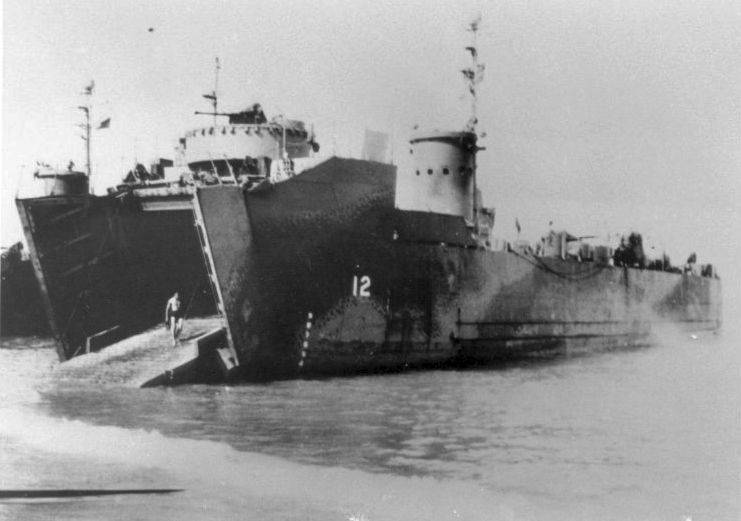 Landing Ship Medium LSM-12
(U.S. Navy)
1 April 1945: American Operation “Iceberg” – The Invasion of Okinawa:
Landing Ship Medium LSM-12
(U.S. Navy)
1 April 1945: American Operation “Iceberg” – The Invasion of Okinawa:
Vice Admiral (later Admiral) Raymond A. Spruance's Fifth Fleet, including more than 40 aircraft carriers, 18 battleships, 200 destroyers and over 1,000 support ships surround Okinawa. LtGen Simon B. Buckner Jr’s Tenth Army (7th, 77th, 96th Infantry, 2nd, 6th Marine divisions) makes amphibious landings and begins the campaign to take the island from the Imperial Army's LtGen Ushijima Mitsuro’s 32nd Army defenders.
At 2100, while screening an LST Group during its night retirement, USS VAMMEN's (DE-644) bow strikes an object (possibly a depth charge dropped by an EMB) that explodes beneath her stern at 26-18N, 127-29E. The destroyer escort's starboard propeller is damaged, but she completes her mission.
That same day, 42nd Shinyo Squadron’s last two EMBs sortie, but both are sunk in Nakagusuku Bay.
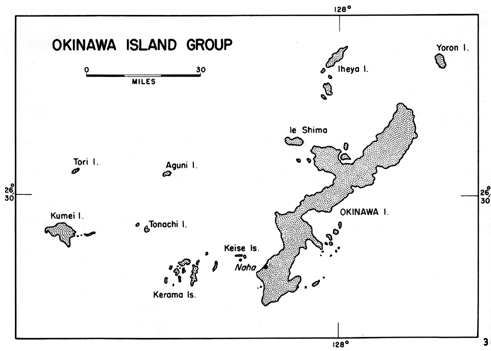 Okinawa
(U.S. Army)
3 April 1945:
Okinawa
(U.S. Army)
3 April 1945:
Rear Admiral Ota Minoru (41)(former XO of YAMASHIRO), CO of the Okinawa Area Auxiliary Base Force, orders all remaining Shinyo to sortie against the American invasion forces.
3/4 April 1945:
Four EMBs of Lt Toyohiro's 22nd SS sortie against the Americans. Not far from their base near Chinen, they attack two Landing Craft Infantry-Gunboats. The EMBs attack the gunboats in pairs. The first pair misses their target astern; but an EMB of the second pair rams Lt (j.g.) Theodore Arnow's LCI (G)-82 just forward of the bridge killing eight crewmen. Arnow orders Abandon Ship and LCI (G)-82 sinks. After this attack, the 22nd SS carries out a total of three more sorties.
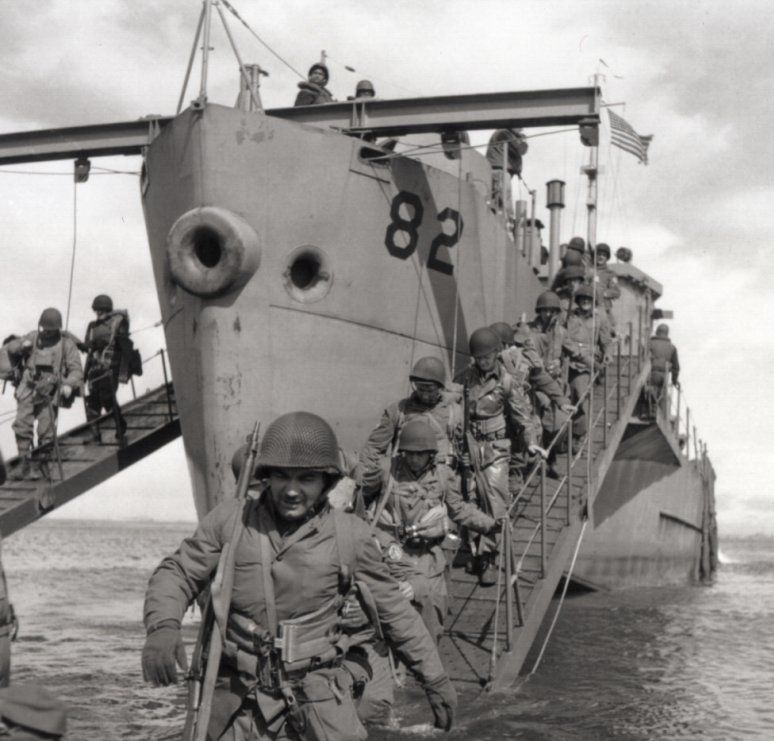 Landing Craft Infantry-Gunboat LCI (G)-82
(U.S. Navy)
9 April 1945:
Landing Craft Infantry-Gunboat LCI (G)-82
(U.S. Navy)
9 April 1945:
In the early morning, destroyer CHARLES J. BADGER (DD-657) lays to at her fire support station at 26-18N,
127-39E. Suddenly, an EMB speeds out of the half light, drops a depth charge close aboard, and races away. The explosion knocks out BADGER’s engines and causes heavy flooding. A tug brings BADGER into the Kerama Retto roadstead. After temporary repairs, she proceeds to Washington state for overhaul.
Off Hagushi. At 0420, while attack cargo ship USS STARR (AKA-67) is loading empty shell casings, the ship is raked by an explosion at 26-20N, 127-44E. EMB No. 325 explodes as it contacts one of a cluster of STARR's landing craft moored along her starboard side. STARR suffers no damage, but the blast injures four men. The two Japanese aboard EMB No. 325 are KIA.
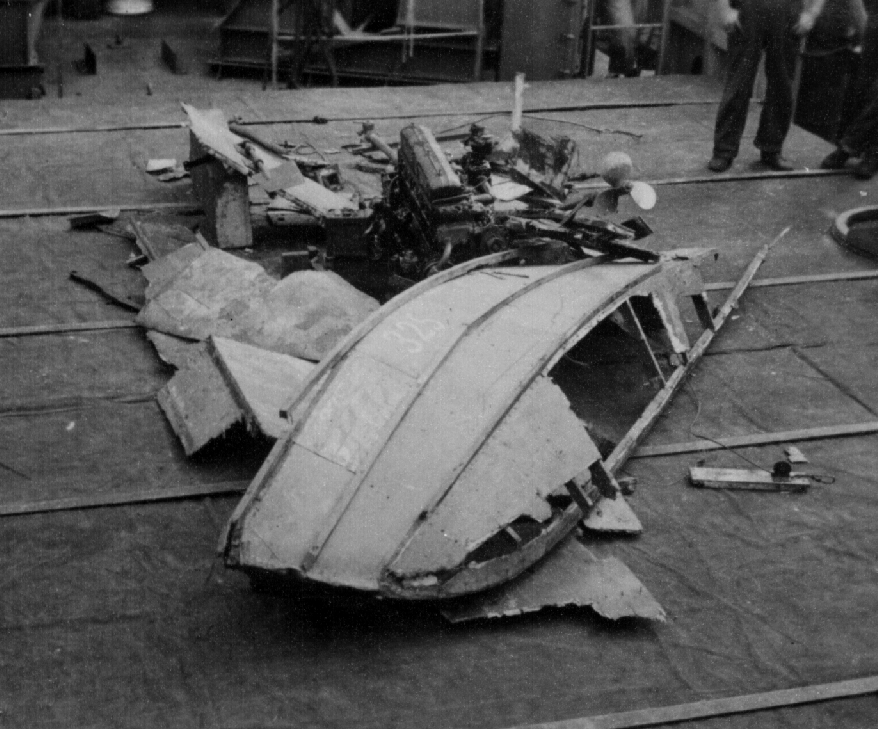 Remains of EMB No. 325 aboard USS STARR (AKA-67)
(U.S. Navy)
15 April 1945:
Remains of EMB No. 325 aboard USS STARR (AKA-67)
(U.S. Navy)
15 April 1945:
W of Naha. Motor minesweeper YMS-331 is damaged by an EMB at 26-15N, 127-36E.
27 April 1945:
Nakagusuku Wan (Buckner Bay). Destroyer USS HUTCHINS (DD-476), while engaged in close support operations, is attacked by EMBs at 26-14N, 127-49E. A small boat slips through the formation and drops two depth charges close aboard. HUTCHINS is shaken violently by the explosions and her hull is damaged severely, but she suffers no casualties. Damage control parties bring flooding under control. HUTCHINS retires to Kerama Retto for temporary repairs. On 15 July '45, she arrives at Portland, Oregon for permanent repairs, but she is scrapped after war's end.
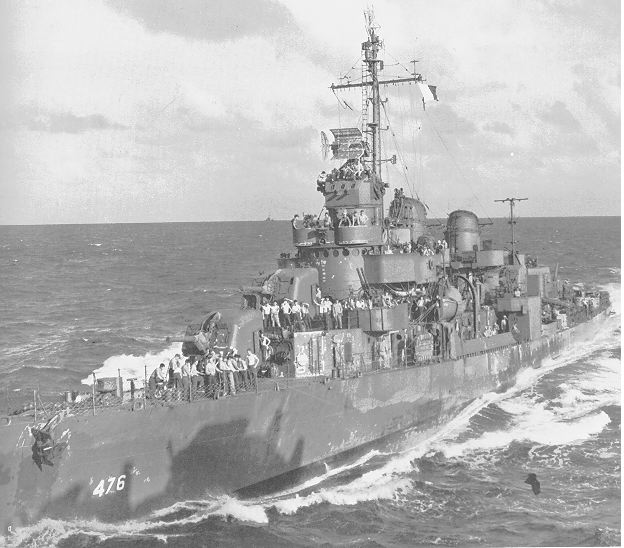 USS HUTCHINS (DD-476)
(U.S. Navy)
28 April 1945:
USS HUTCHINS (DD-476)
(U.S. Navy)
28 April 1945:
An EMB damages cargo ship BOZEMAN VICTORY (VC2-S-AP3). The explosion injures six men among the 59-man merchant crew. 13 stevedores and men in the "Victory" ship's Armed Guard also suffer injuries.
4 May 1945:
Nagagusuku Bay. Coast Guard-manned PC-469 is on anti-sub patrol in the area. At 0035, three small craft are sighted at about 1,000 yards. PC-469 challenges the boats, but it is not answered. The boats are identified as Japanese EMBs. PC-469 opens fire. One EMB is sunk about 40 yards astern. PC-469 observes an explosion and an underwater concussion is felt throughout the subchaser. The two remaining boats clear out to about 600 yards. At 0050, TG 51.19’s destroyers illuminate the EMBs. PC-469 sinks another suicide boat about 75 yards off the starboard quarter.
 PC-469-type subchaser
(U.S. Navy)
N end of Nakagusuku Wan. That same day, an EMB rams cargo ship USS CARINA (AK-74) port side at 26-13N, 127-50E. The explosion buckles deckplates, tears a hole in the transport's side, knocks out a boiler and causes flooding of a hold. Six of CARINA’s crewmen are injured. Skillful damage control saves CARINA and her cargo. She completes unloading, then heads for repairs at Ulithi.
PC-469-type subchaser
(U.S. Navy)
N end of Nakagusuku Wan. That same day, an EMB rams cargo ship USS CARINA (AK-74) port side at 26-13N, 127-50E. The explosion buckles deckplates, tears a hole in the transport's side, knocks out a boiler and causes flooding of a hold. Six of CARINA’s crewmen are injured. Skillful damage control saves CARINA and her cargo. She completes unloading, then heads for repairs at Ulithi.
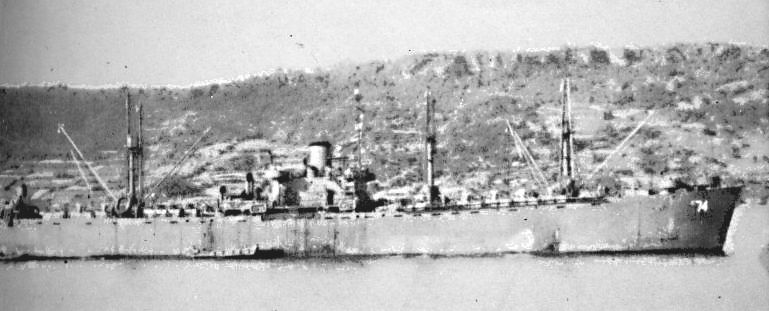 USS CARINA (AK-74) after EMB attack
(U.S. Navy)
May 1945:
USS CARINA (AK-74) after EMB attack
(U.S. Navy)
May 1945:
After the American landing, the 22nd SS switches to land battles and carries out night attacks while entrenched in the mountains of the northern part of the island. However, without weapons, without food, many of the squadron's men eventually take their own lives.
15 May 1945:
All other IJN and IJA EMBs are eliminated as operational combat units. Their crews also continue fighting as infanty near Naha.
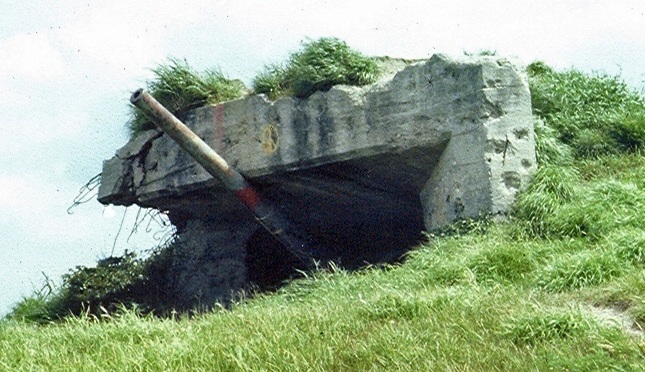 Japanese gun emplacement near Naha
(Hackett collection)
12 June 1945:
Japanese gun emplacement near Naha
(Hackett collection)
12 June 1945:
Oroku Peninsula, near Naha. At 1600, Rear Admiral Ota sends a last signal to the island commander LtGen Ushijima. Five days later, U. S. Marines of the Sixth Marine Division enter Ota's headquarters and find he and his staff had commited ritual suicide. The Japanese promote Ota to Vice Admiral, posthumously.
18 June 1945:
Southern tip of Okinawa. The CG U.S. Tenth Army, LtGen Simon Bolivar Buckner, Jr. (son of Confederate LtGen Simon Bolivar Buckner) is killed by a Japanese artillery shell. MajGen (later Gen) Roy S. Geiger, USMC, assumes command of Tenth Army. [3]
21 June 1945:
At 1700, Okinawa is declared secure. During the 88-day campaign, almost 700 suicide boats supported by about 7,000 troops, sank but two American ships and damaged five and probably damaged another.
23 June 1945:
Gen Joseph W. (“Vinegar Joe”) Stilwell, USA assumes command of Tenth Army from Geiger.
7 September 1945:
U.S. Tenth Army Headquarters, Okinawa. LtGen Nomi Toshiro surrenders all Japanese forces in the Ryukyu Islands. Nomi also surrenders his Shin-Gunto samurai sword (with general officer's knot) to Gen Stilwell.
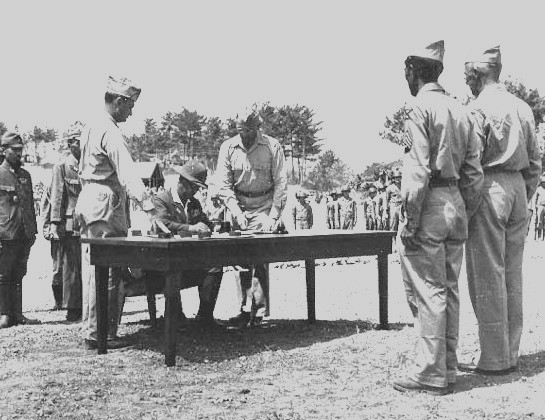 Gen Stilwell (far right) watches LtGen Nomi sign the surrender document
30 March 1964:
Gen Stilwell (far right) watches LtGen Nomi sign the surrender document
30 March 1964:
Kadena AB, Okinawa. The USAF erects a monument at the site of the surrender that includes the full text of the 1945 surrender document and an inscription that reads "To the Importance of Everlasting Peace and Understanding Among all Peoples of the World".
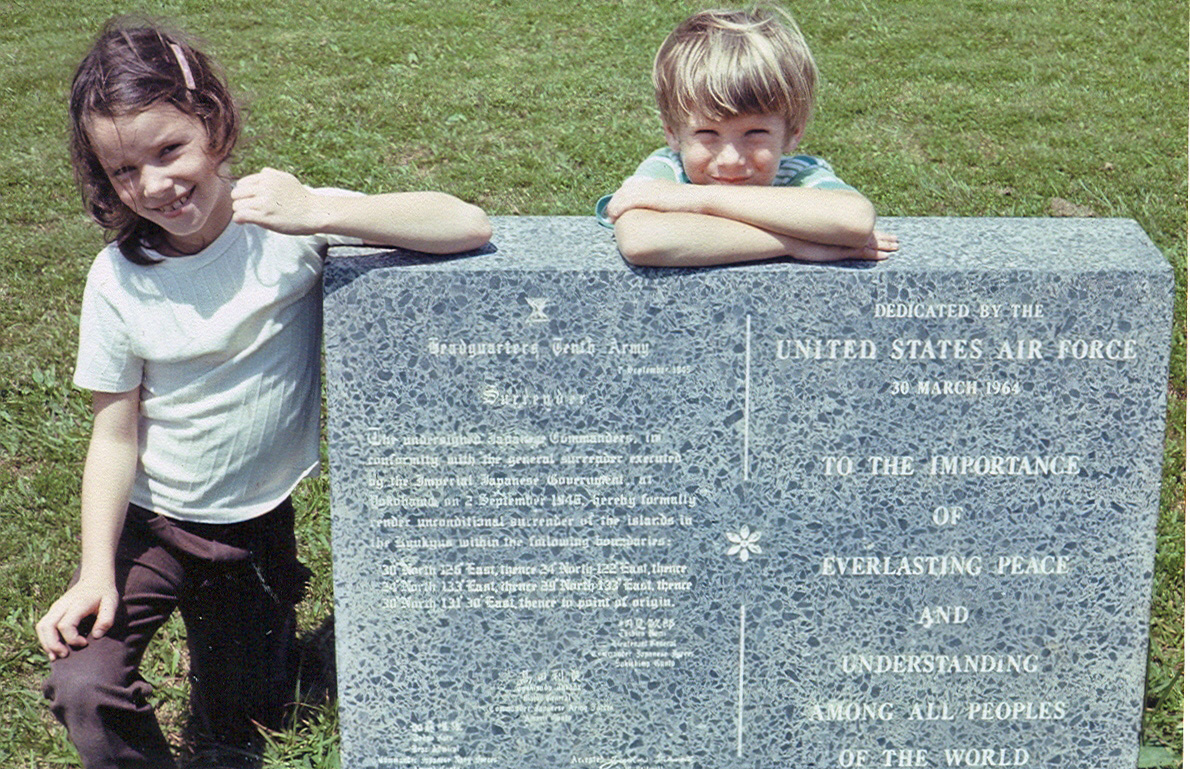 Two of Bob Hackett's kids (later both Air Force full colonels and Iraq vets) in 1969 at the site of the surrender
Two of Bob Hackett's kids (later both Air Force full colonels and Iraq vets) in 1969 at the site of the surrender
their grandfather and the 77th Infantry Division helped bring about in 1945.
August 1971:
Kin Town. A small monument is erected to honor 74 men of the 22nd Shinyo Special Attack Squadron who were KIA in battle. It stands in front of the Public Hall, a short distance from Kin Bay.
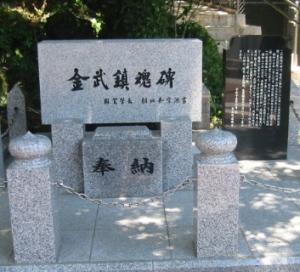 22nd Shinyo Special Attack Squadron's monument
22nd Shinyo Special Attack Squadron's monument
Authors’ Notes:
[1] Another source says 39 crew, 21 Army, and 262 passengers were KIA.
[2] In addition to the IJN's Shinyo units on Okinawa, the Imperial Army deployed seven Sea Raiding Regiments (1st, 2nd, 3rd, 26th, 27th, 28th and 29th) from Kyushu to Okinawa between September 1944 and February 1945. A sea raiding “regiment” was a company-sized unit of 104 men and 100 boats, including spares, supported by a base battalion of about 900 men. In February 1945, LtGen Ushijima converted the seven Sea Raiding Regiments into independent battalions for duty as infantry troops on the main island of Okinawa to back fill the shortage resulting from withdrawal of the IJA's 9th Division to Formosa.
[3] LtGen Buckner was the highest-ranking American military officer killed by enemy fire in WWII. Geiger became the only Marine to command a numbered army of the US Army in combat.
Japanese records seldom detail individual EMB attacks. While U.S. wartime records describe EMB attacks, they most often do not distinguish between the IJN's "Shinyo" and the IJA's "Maru-ni". In most cases, therefore, our TROMs simply refer to both service's suicide boats as "EMBs".
Thanks go to John Whitman for info about the 39th Shinyo Squadron.
-Bob Hackett and Sander Kingsepp
Back to Explosive Motorboats
Page





















